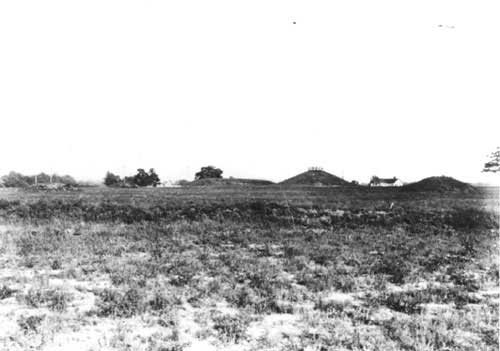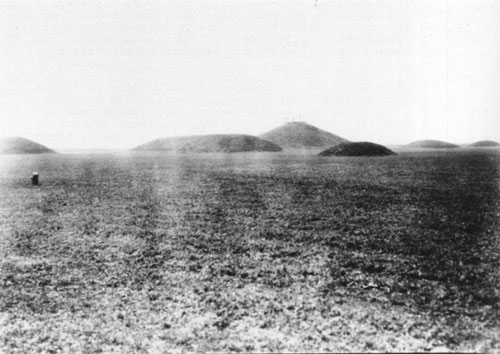Administrative History

|
Hopewell Culture
Administrative History |

|
CHAPTER TWO
Preservation of the Mound City Group (continued)
| President Harding Proclaims a National Monument |
Camp Sherman had helped transform sleepy Chillicothe into a thriving economic center in south-central Ohio. Peacetime brought about new opportunities for use of the large federal holdings to the city's north. Albert C. Spetnagel remained determined to secure a safe future for the prehistoric Hopewell mounds at Mound City Group. The impending demise of Camp Sherman forecast an uncertain future for the mounds. Spetnagel's effort gained credible support when William C. Mills announced his support for a "national park" at Mound City Group. It represented a fourth suggested use for the military reservation, the others being a training center for disabled soldiers, a reformatory for youths, and a citizens' military training grounds. [12]
Ohioans desirious of preserving Camp Sherman in any form conducted a furious letter-writing campaign directed at President Warren G. Harding, himself a native Ohioan. Many letters were sent to the president's personal physician and confidant, Brig. Gen. Charles E. Sawyer. One letter, from Ohio State Archaeological and Historical Society Secretary C. B. Galbreath declared the prehistoric earthworks should be "under the custody of the state or national government."
Galbreath explicitly offered to assume guardianship of the 117-acre farm containing Mound City Group with a plan to operate it on a self-sustaining basis. He concluded by affirming, "The transfer of this farm to the custody of our society would in no way interfere with the other uses that have been suggested for the large Camp Sherman tract of land." Impressed by the society's offer, and letters of support from the Smithsonian Institution and other scientists, Sawyer pledged to dispatch his son, Dr. Carl Sawyer of Marion, Ohio, to inspect the site and deliver a recommendation. [13]
The U.S. Veterans Bureau, newly charged with Camp Sherman, did not object to use of Mound City Group for park purposes. In October 1921, bureau chief C. R. Forbes inspected the site and conveyed his decision to retain title to the land, but to allow the Ohio State Archaeological and Historical Society to develop a state park there. [14]
At the grassroots level, Albert C. Spetnagel lead a civic committee dedicated to ensuring the preservation of the mound group. Utilizing the auspices of Chillicothe's newly-formed Rotary Club chapter, Spetnagel's committee worked with Ohio political figures, and first proposed designation of "Mound City Group National Monument" in 1921 utilizing executive branch powers authorized by the Antiquities Act of 1906. Because there was no legislative mechanism to do otherwise short of a time-consuming act of Congress, the group strategized retaining the proposed national monument under War Department jurisdiction; however, its daily administration and operation would be as a state memorial of the Ohio State Archaeological and Historical Society.
Thanks to the mechanism provided by the 1906 Antiquities Act, their preservation effort easily bore fruit. On March 2, 1923, President Warren G. Harding signed proclamation 1653 establishing the Mound City Group National Monument on fifty-seven acres along the Scioto River. [15] Harding's statement called the prehistoric mounds "an object of great historic and scientific interest and should be permanently preserved and protected from all depredations and from all changes that will to any extent mar or jeopardize their historic value." [16] The 1906 Antiquities Act, originally passed to protect archeological resources in the American Southwest from vandals, gave the president the right to declare "historic landmarks, historic or prehistoric structures, and other objects of historic or scientific interest... to be national monuments" anywhere in the country. Afflicted by willful abuse and damage under previous terms of federal stewardship, Mound City Group National Monument could only hope for more prudent care.
Because the federal government had not developed a statement of purpose for the country's national monuments, most remained in limbo with volunteer caretakers overseeing them. Congress allocated almost no funding for their development or care. Even upon the National Park Service's creation in 1916, America's national monuments received scant attention from the new bureau, a practice that continued until the New Deal era when the majority of such sites transferred to NPS administration and Congress loosened its pursestrings. The legacy of second-class status, however, did not quickly evaporate. Therefore, the decision to seek non-federal stewardship for Mound City Group proved fortuitous. [17]
Twenty-five days following President Harding's action, Assistant Secretary of War Dwight F. Davis executed a revocable license per the plan of Spetnagel's Rotary Club committee. The license read as follows:
The Ohio State Archaeological and Historical Society is hereby granted a license, revocable at will by the Secretary of War, to care for, preserve, protect, and maintain the "Mound City Group" of historic mounds located on the Camp Sherman Military Reservation at Chillicothe, Ohio, and declared a national monument by Presidential Proclamation No. 1653, dated March 2, 1923, under authority of Act of Congress approved June 8, 1906 (34 Stat. 2251), and for that purpose to occupy the tract of land upon which they are situated, which tract was reserved by said proclamation as the site of the said monument, the site so reserved and hereby authorized to be occupied and cared for being described as follows:
All of Sections N and O, bounded on the north by East Liverpool Street, on the east by the Scioto River, on the west by Columbus Avenue, and on the south by Portsmouth Street, containing fifty-seven (57) acres, more or less.
The license is granted upon the following provisions and conditions:
1. That the said site shall be open to all people desiring to visit these mounds and shall be properly cared for and policed by the licensee without any expense whatever to the United States.
2. That no buildings or structures of any kind whatever shall be erected upon the property without the consent of the Secretary of War.
3. That no excavations of the said mounds shall be allowed, except upon permission granted by the Secretary of War. [18]
The War Department and its Veterans Bureau had little to no interest in the Mound City Group National Monument. Federal authorities were only too happy to permit Ohio officials to care for and operate the monument. By 1930, of the sixteen national monuments under the War Department's care, fifteen were expressly related to military operations significant to the nation's history. Mound City Group clearly did not fit that mold, and only remained under the War Department's purview because it was surrounded by the former Camp Sherman Military Reservation governed by the Veterans Bureau. Ohio's offer seemed like the best possible option to federal military officials perplexed by the innocuous piece of real estate known as Mound City Group National Monument. [19]
 Figure 15: Mound City Group restoration of the mid-1920s, looking southeast. Death Mask Mound in center features stairs and viewing platform. (NPS/ca. 1927) |
 Figure 16: Mound City Group restoration of the mid-1920s, looking southwest. Note a Camp Sherman-era remnant fire hydrant at left. (NPS/ca. 1927) |
CONTINUE >>>